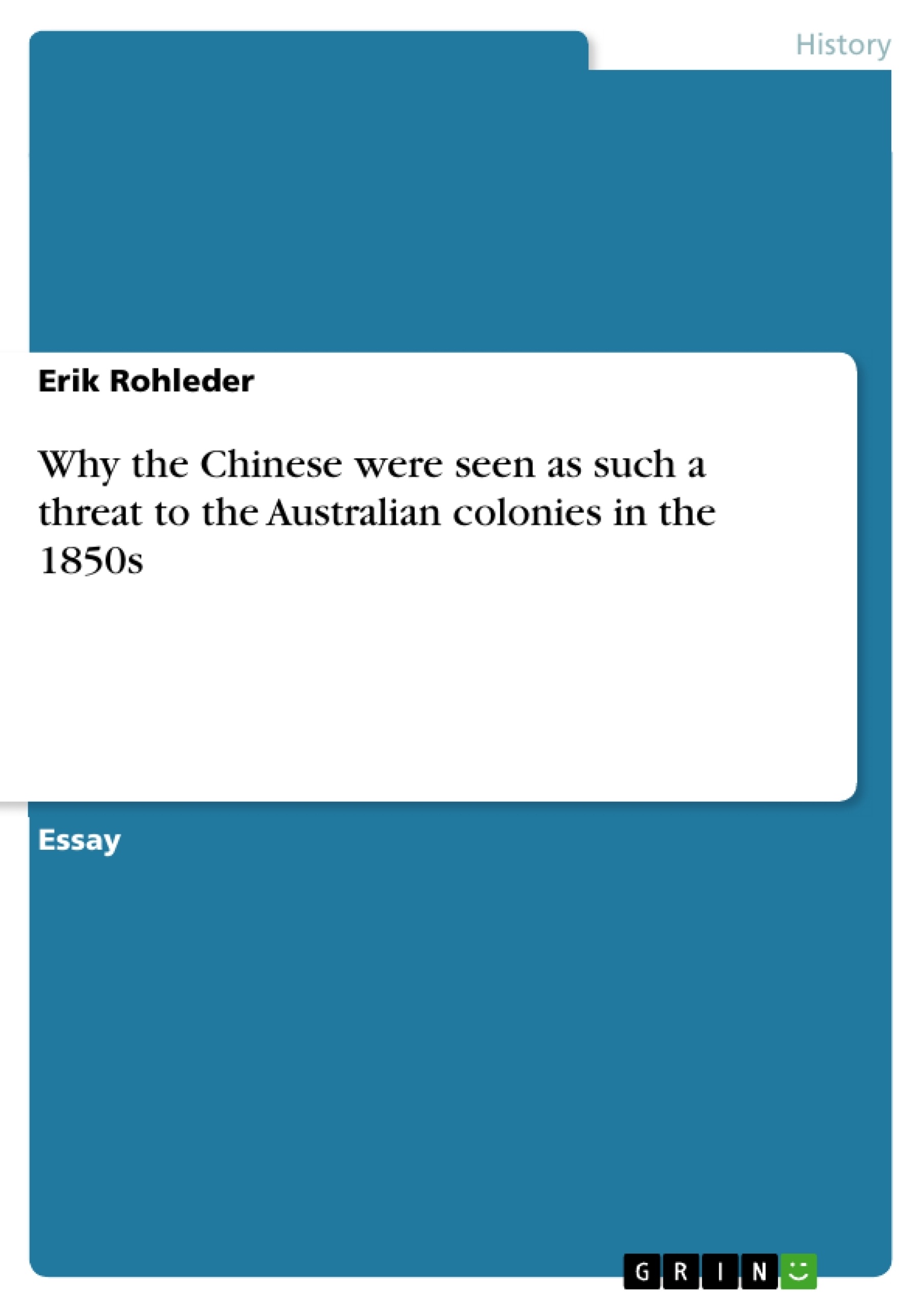Since the early 1850s, when the first gold was found in Australia, several tens of thousands of migrants settled there and tried to solve their economic difficulties back home. A great number of them were Chinese, but they were not as welcomed as Europeans or Americans. Soon after their settlement, demonstrations and riots took place against them. Chinese diggers became casualties of violent acts and were hunted by the white colonists. But which perils and fears caused their presence? Why were they seen as such a threat to Australian colonies? This paper will look at four main reasons for this resistance against the Chinese. One of these were the experiences and forewarned stories of the Californian gold fields. Secondly, I am going to discuss the political fears concerning to a weakening by this mass of migrants. Another main reason for the Chinese to be seen as a threat, were economical factors and everyone’s desire to seize the gold as their own, which caused many potential conflicts. Lastly, there were many differences between the colonists’ cultures. Their language, way of work, religion and the uncertainty about each other significantly divided both parties.
Table of Contents
- Introduction
- The Impact of the Californian Gold Fields
- Political Fears of Chinese Domination
- Economic Concerns and Competition for Gold
- Cultural Differences and Prejudice
Objectives and Key Themes
This essay examines the reasons why Chinese migrants were perceived as a threat to the Australian colonies in the 1850s. It explores the historical context of Chinese migration to Australia, the influences of earlier experiences in California, and the specific anxieties surrounding the Chinese influx in terms of political, economic, and cultural factors.- The role of the Californian gold rush in shaping perceptions of Chinese migrants
- Political fears surrounding the potential for Chinese dominance and social change
- Economic concerns related to competition for resources and the perceived threat to European livelihoods
- Cultural differences, prejudice, and the impact of xenophobia on the treatment of Chinese migrants
Chapter Summaries
- The essay begins by highlighting the rapid influx of Chinese migrants to Australia during the gold rushes of the 1850s. It emphasizes the stark contrast between the welcome given to European migrants and the resistance faced by the Chinese. The paper then outlines four key reasons for this opposition.
- The first reason explored is the impact of the experiences and narratives surrounding the Californian gold rush. It highlights the anxieties surrounding the large influx of Chinese in California and the perceived threat to American dominance in the gold fields. This experience is presented as a key factor influencing Australian perceptions.
- The second section delves into the political fears surrounding Chinese migration. It focuses on anxieties about Chinese influence on Australian society and the potential for a shift in power dynamics. The essay explores concerns regarding the government's ability to control the large influx of Chinese and the potential for social and political instability.
- The third chapter analyzes the economic concerns and conflicts arising from the presence of Chinese miners. It emphasizes the competition for gold, the perceived threat to European livelihoods, and the resentment towards the Chinese for their success in the gold fields. The chapter discusses the economic arguments used to justify the discrimination against the Chinese.
- The final section of the essay addresses the cultural differences and prejudices that fueled the resistance against Chinese migrants. It explores the impact of language barriers, differing work practices, and religious beliefs on the interaction between Europeans and Chinese. The chapter highlights the role of xenophobia and cultural anxieties in shaping the hostility towards the Chinese.
Keywords
The primary keywords and themes explored in this essay include Chinese migration, gold rushes, Australian colonies, prejudice, xenophobia, cultural differences, political fears, economic concerns, and the influence of the Californian gold rush. These themes highlight the complex interactions between colonial anxieties, economic competition, and cultural prejudices that shaped the experience of Chinese migrants in Australia during the 1850s.- Citar trabajo
- Erik Rohleder (Autor), 2010, Why the Chinese were seen as such a threat to the Australian colonies in the 1850s, Múnich, GRIN Verlag, https://www.grin.com/document/152484



